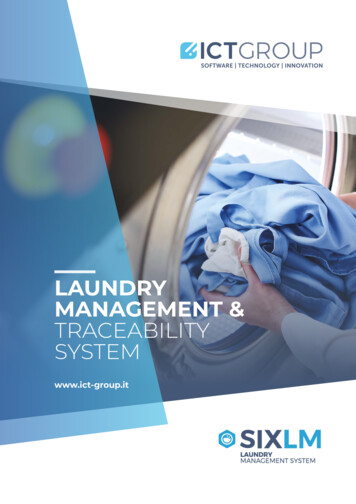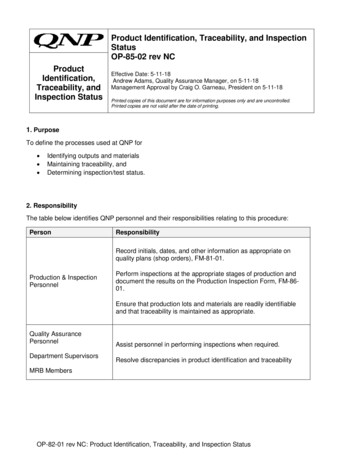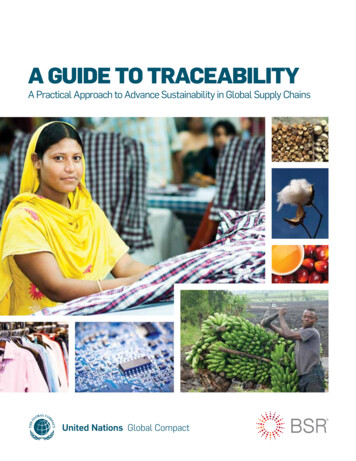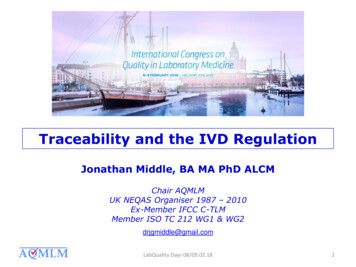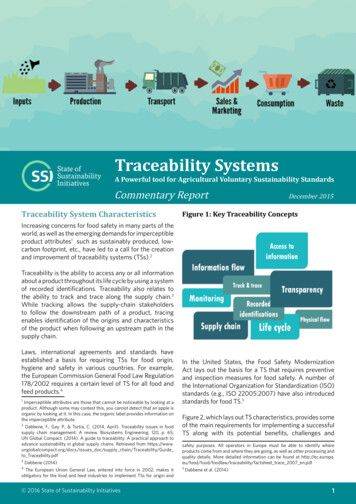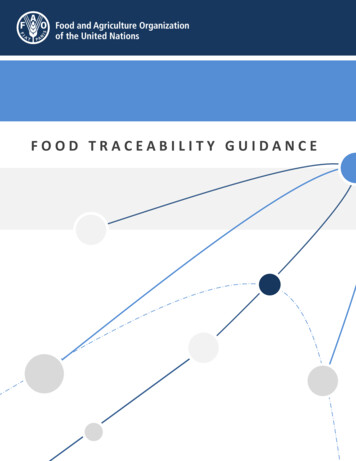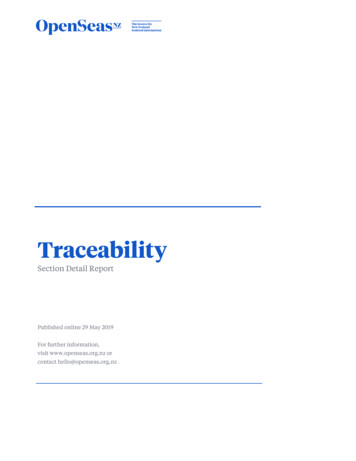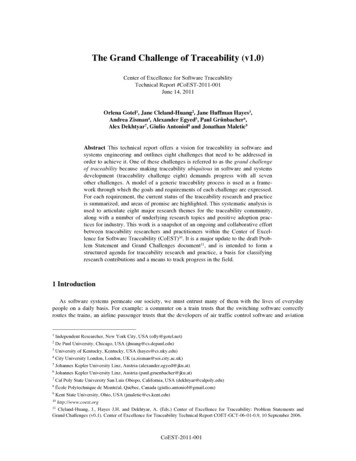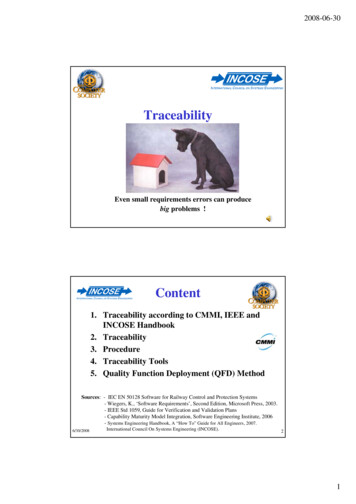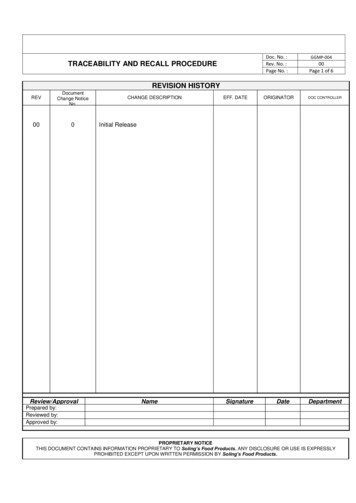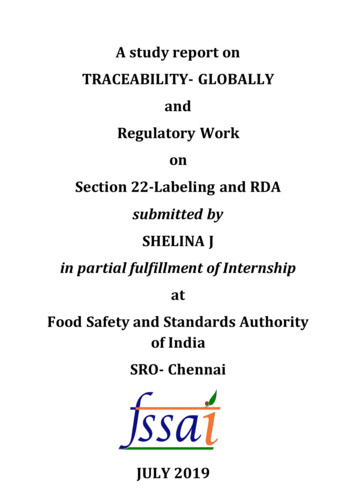
Transcription
A study report onTRACEABILITY- GLOBALLYandRegulatory WorkonSection 22-Labeling and RDAsubmitted bySHELINA Jin partial fulfillment of InternshipatFood Safety and Standards Authorityof IndiaSRO- ChennaiJULY 2019
BONAFIDE CERTIFICATEThis is to certify that Ms Shelina J has submitted a studyreport on “Study of Traceability – Globally” carried outduring the Internship at “Food Safety and StandardsAuthority of India-Chennai”. This wok is a record ofstudent’s own work under the guidance and supervision ofthe undersigned.Ms W Lydia Sona LizzyDr M Kannan(Technical Officer)(Deputy Director)FSSAI- ChennaiFSSAI- Chennai
DECLARATIONI hereby declare that the study reportentitled “Traceability-Globally” is a workdone in partial fulfillment of Internship atFood Safety and Standards Authority ofIndia (FSSAI)- Chennai. All sources of workhas been duly acknowledged.DATE: (SHELINA J)PLACE:
ACKNOWLEDGEMENTI would like to thank at first The Almighty for his bountiful support and hisblessings.At first, I would like to thank The CEO of FSSAI Shri Pawan Kumar Agarwaland Dr Sanjay Dave the Chairperson of Surakshit Khadya Abhyan for givingthis opportunity of Internship at FSSAI-Chennai.I would like to extend my sincere gratitude to the Director of FSSAIChennai and Mumbai “ Shri P Muthumaran” for his support during theinternship.Heartiest thanks to “Dr M Kannan” the Deputy Director of FSSAI-Chennaifor his humble support ,his endeavours during the complexities and histimely guidance which has helped a lot to enlighten and grow and learn.Deepest thanks and sincere appreciation to “Ms W Lydia Sona Lizzy”Technical Officer at FSSAI-Chennai for all her distinguished efforts to makeme well equipped with the norms and give a lot of real time experience inunderstanding the regulations and importance.At last, great thanks to the entire office members of FSSAI-Chennai as wellas the supporting staff and the Interns for all the help they have renderedduring the period of internship.
TABLE OF 4TitleIntroductionIntroductionSalient Features of FSSAINetwork of FSSAIThe Indian Food LawFSS ActFSS RulesFSS RegulationsFSS RegulationsThe Authorities in FSSAIFSSAI Southern Regional Office ChennaiFood Licensing and Registration of FoodBusinessCriteria For Central Licensing AuthorityCriteria for State Government LicenseCriteria for RegistrationFood Licensing and Registration SystemMandatory DocumentsFood License Number and its DenotationSection 22- Surveillance on Labeling, RDA andClaimsLabelling, RDA, Claims- ComplianceList of Companies ScrutinizedInferenceSafety of Street Food – Measures at variousstakeholders levelRaw Material SupplierSafety at the Raw Material Supplier levelFood HandlerSafety at the Food Handler LevelFood RegulatorLocal Bodies/NGO’s/SHG’sConsumersFood Safety at Consumers LevelAdvertisements and Claims Regulation 2018The Formation of RegulationNeed for the RegulationHealth ClaimsNutrient Function ClaimsOther Function ClaimsReduction of Disease Risk ClaimsCondition of Health ClaimsPage 617171717
56.66.76.86.97Nutrition ClaimNutrient Content ClaimNutrient Comparative ClaimCriteria for Nutrition ClaimNon Addition ClaimNon Addition Claim of SugarNon Addition Claim of SaltNon Addition Claim of AdditiveClaims related to Dietary Guidelines orHealthy DietsApproval of ClaimsProcedure for Approval of ClaimsRedressal of Non ComplianceCorrective AdvertisementImportLicensing by Food AuthorityFood Import ClearanceFood Import Clearance SystemMandatory DocumentsVisual InspectionSampling and AnalysisStorage of Imported food/SamplesPackaging Compliance of Imported FoodVarious Forms in ImportInspection-Import181818181818181819Study on TraceabilityDefinition of TraceabilityFood Poisoning cases in IndiaRegulatory Requirements across GlobeCertifications enhancing TraceabilityTechnologies supporting TraceabilityImplementation RequirementsDesigning Traceability systemsEnhancing usion202020202121212122232323242425
CHAPTER 1INTRODUCTION1.1 INTRODUCTIONFSSAI has been established under the FSS Act 2006 which was passed byAnbumani Ramodass. The FSSAI has been appointed the duty of forming theRegulations. It’s a sole body responsible for Ensuring safety in food. The body isautonomous to Ministry of Health and Family welfare which has been the parent bodyof the newly formed young regulatory.Before the existence of FSSAI, the Prevention of Food Adulteration Act 1954 hadits hand on the food commodities. The main objective of PFA was into the concept ofAdmixture i.e adulteration, there were not much provisions for improvement. Theentire section of the act was based on Penalties.There were also nine differentministries and eight different laws. Therefore there was a need for ease in the law and achange to be made so as to allow improvement chances in the food industry along withthe removal of overlapping of such laws which made the roots for the formation ofFSSAI.Table 1.1 Laws and Ministries before FSSAIPrevention of Food Adulteration Act 1954Edible Oil Product OrderVegetable Oil Packaging OrderMilk and Milk Product OrderMeat Product OrderFruit Product OrderStandard Weight and Measures ActAny Order under essential Commodities Act1
The FSSAI was formed in 2011, where the act was passed in 2006. The FSSAI had beingformulated so as to have Removal of Multiple lawsHarmonizing with International lawsScientific Evaluation and Risk based assessment approachTrade without affecting consumer safety1.2 SALIENT FEATURES OF FSSAI The FSSAI has Science based standardsThe Standards of FSSAI are based on some international standards suchas Codex, so as to promote International TradeThe major initiative is to ensure consumers safetyTo provide legal provisions for consumer healthFocuses more on Food Safety and Management SystemTimely update on the Regulations and formation of regulations based onthe need of the Indian Market1.3 NETWORK OF FSSAIThe FSSAI is led by the Chief Executive Officer who has the highest authority.There are about five Regional Offices with Headquarters at New Delhi and the otherquarters at Mumbai, Kolkata, Chennai, Tuticorin.2
NEW DELHIGUWAHATIKOLKATAFSSAIMUMBAICHENNAI1.4 THE INDIAN FOOD LAW1.4.1 FSS ActThe FSS Act was passed in 2006. The act has all the sections which give the definitionsand the pros and cons. It gives an idea about the responsibility and the provisions forunderstanding the Regulation. There are about 101 sections in the act which covers theentire food law.1.4.2 FSS RulesThe Rules speak about the amenities to be provided.1.4.3 FSS RegulationsThe regulations reveal the scientific aspect of the law and there can be changes andamendments made according to the need of the hour.1.4.3.1 FSS RegulationsThere are timely updates and changes as well as if the need of New Regulation isrequired is made. At first a draft is notified and after the scientific analysis a GazetteNotification is made which becomes the land of the law.2011 Food Safety and Standards (Licensing and Registration of FoodBusinesses) RegulationFood Safety and Standards (Food Product Standards and Food Additives)RegulationFood Safety and Standards (Prohibition and Restriction on Sales)RegulationFood Safety and Standards (Packaging and Labelling) RegulationFood Safety and Standards (Contaminants, Toxins and Residues)Regulation3
Food Safety and Standards (Laboratory and Sampling Analysis)Regulation Food Safety and Standards (Food or Health Supplements, Nutraceuticals,Foods for Special Dietary Uses, Foods for Special Medical Purpose,Functional Foods and Novel Food) Regulation Food Safety and Standards (Food Recall Procedure) RegulationFood Safety and Standards (Import) RegulationFood Safety and Standards (Approval for Non-Specified Food and FoodIngredients) RegulationFood Safety and Standards (Organic Food) Regulation20162017 2018 Food Safety and Standards (Alcoholic Beverages) RegulationFood Safety and Standards (Fortification of Foods) RegulationFood Safety and Standards (Food Safety Auditing) RegulationFood Safety and Standards ( Recognition and Notification of Laboratories)RegulationFood Safety and Standards ( Advertising and Claims) RegulationFood Safety and Standards (Packaging) Regulation1.5 THE AUTHORITIES IN FSSAI4
1.6 FSSAI SOUTHERN REGIONAL OFFICE- CHENNAIThe FSSAI- Chennai is the Southern Regional Office which holds the following states Tamil NaduKeralaTelanganaKarnatakaAndhra PradeshPondicherryLakshwadeepThe following two divisions are held under in FSSAI Chennai1. Licensing2. ImportLicenseFSSAISRO5Import
CHAPTER 2FOOD LICENSING AND REGISTRATION OF FOOD BUSINESSSection 31 of the act deals with the Licensing and Registration of theFBO. The food licensing and Registration Regulation gives instructions,criteria to attain License, the process of obtaining license, the various formsinvolved in the attaining of license, the hygiene requirements to bemaintained by various Food Business Operators (FBO).All Food Business Operator involved in the Food Business arerequired to get Licensed by the Food Authority based on the followingcriteria.TABLE 2.1 CRITERIA FOR FOOD BUSINESSCRITERIAREGISTRATIONSTATE LICENSEFormForm A- Schedule Form2Schedule 2CENTRALLICENSEB- Form BSchedule 1Fees- Schedule Rs 100Rs 5000 or 30003Turnover/ year Less than 12 lakhs 12 lakhs – 20croresMandatorySchedule 4Schedule 4Rs 7500More thancroresSchedule 420Schedule 1 – Criteria of Food Business under Central Licensing AuthoritySchedule 2- Various forms for the application of License/ RegistrationSchedule 3- Fess for the applied license/ RegistrationSchedule 4- General Hygiene PracticesTABLE 2.2 SCHEDULE IV PARTSPart 1General Hygiene and SanitaryPractices to be followed by FBO forRegistration6
Part 2General Hygiene and SanitaryPractices to be followed by FBO forLicenseHygiene and Sanitary Practices ofMilk and Milk ProductsHygiene and Sanitary Practices ofMeat and Meat ProductsCaterersPart 3Part 4Part 52.1 CRITERIA FOR CENTRAL LICENSING AUTHORITYThe following list of FBO’s come under CLA Dairy Units- 2500 MT / day Slaughter house- 50 large animals, 150 small animals, 1000 poultrybirds/day Vegetable Processing Unit- 2MT /day Meat Processing Unit- 500 kg / day , 150 MT per annum 100% Export Oriented Units Companies operating in more than two or more state Catering services such as for Central Government Agencies such asRailways, Airways2.2 CRITERIA FOR STATE GOVERNMENT LICENSE Manufacturer- above 1 MT Dairy- 2500 MT per annum Hotels- 3 star and above2.3 CRITERIA FOR REGISTRATIONThe criteria not fulfilled by 2.1 and 2.2 come under Registration category2.4 FOOD LICENSING AND REGISTRATION SYSTEM (FLRS)7
The FLRS is an online platform which was introduced by FSSAI to promotethe application for license via the online platform.2.4.1 STEPS INVOVLED IN APPLICATION OF LICENSE8
Application of License dependingon the KoB and CriteriaScrutiny of Application by theauthorityIf Modification response from theapplicant within 30 daysPre/ Post InspectionBusiness may start if no approvalwithin 60 days from Authority2.5 MANDATORY DOCUMENTS Form B filled and SignedBlueprint of the LayoutList and Address proofsList of Food CategoryAnalysis ReportDGFT if applicableFSMS PlanNOC wherever applicable2.6 FSSAI LICENSE NUMBER AND ITS DENOTATIONThe FSSAI License number is a 14 digit number where each digit holds adenotation to it100180419001606
TYPE OFLICENSEYEARSTATE CODENo Of license issuedCentral License –The number start with 1 followed with 0State License- The number starts with 1 followed by 2 and other valuednumeralRegistration- The number starts with 22.7 SECTION 22- REGULATORY WORK ON LABELLING, RDA ANDCLAIMSThe section 22 speaks about Genetically modified foods, functionalfoods, organic foods, proprietary foods etcThis section deals with the various types of food under this categorycannot be sold as such by the manufacturer in any case and there has tobe adherence of the product with respect to pertaining Regulations.Currently, Proprietary Foods are foods which do not have standardsset by the Regulatory but their ingredients should be mentioned in anyof the Regulations.The other categories such as that of the Nutraceuticals, Food forSpecial Medical Purpose, Health Supplement, Foods for Special DietaryUse, Prebiotics, Probiotics have the newly set Standards in the year2016, with Implementation on 2018.The products in this categories have to the Additives only from theSchedules mentioned belowTABLE 2.7 SCHEDULESSchedulesSchedule IDescriptionList of vitamins and minerals andtheir componentsList of Amino acids and theirComponentsSchedule II10
Schedule IIIValues for vitamins, minerals andtrace elements allowed to be usedin food for special dietary use andfood for special medical purpose(other than those intended for usein infant formula)List of Plant or botanicalingredientsAdditivesNutraceutical IngredientProbiotic ingredientsPrebiotic IngredientsSchedule IVSchedule VSchedule VISchedule VIISchedule VIII2.7.1 LABELING , RDA , CLAIMS COMPLIANCEThe labeling of the products was done in accordance to theRegulation by following the list of additives, ingredients mandatory withrespect to the category of the food in order to make a claim pertaining tothe respective food. The ingredient and additive list was also verified- amandatory document in Form B.The RDA was estimated by following the Dietary Allowance chart assuggested by the FSSAI regulatory. In certain cases the RDA oscompounds not mentioned here were calculated with respect to ICMR,Codex guidelines. The RDA was calculated in respect to that of Sedentar
STEP 1: Arrival of Food Consignment at the Customs STEP 2: Form forwarded from Customs to Food Import Clearance System (FICS) STEP 3: Scrutiny of document (FICS) and fee payment STEP 4: Visual Inspection by the Officer – FORM 1 STEP 5: Two Samples collected- i. Representative sample ii.
